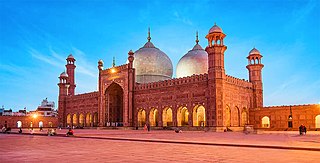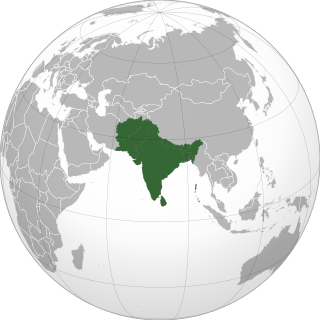
Babur was the founder of the Mughal Empire in the Indian subcontinent. He was a descendant of Timur and Genghis Khan through his father and mother respectively. He was also given the posthumous name of Firdaws Makani.

Lahore is the capital and largest city of the Pakistani province of Punjab. It is the second largest city in Pakistan, after Karachi, and 26th largest in the world, with a population of over 14 million. Located in central-eastern Punjab, along the River Ravi, it is the largest Punjabi-speaking city in the world. Lahore is one of Pakistan's major industrial, educational and economic hubs. It has been the historic capital and cultural center of the wider Punjab region, and is one of Pakistan's most socially liberal, progressive, and cosmopolitan cities.

The First Battle of Panipat, on 21 April 1526 was fought between the invading forces of Babur against Ibrahim Lodi, the Sultan of Delhi, in North India. Babur's forces, employing gunpowder firearms and cannons, defeated Ibrahim. This was one of the earliest battles involving gunpowder arms on the Indian subcontinent. The victory marked the beginning of Mughal rule in India.

The Muslim period in the Indian subcontinent or Indo-Muslim period is conventionally said to have started in 712, after the conquest of Sindh and Multan by the Umayyad Caliphate under the military command of Muhammad ibn al-Qasim. It began in the Indian subcontinent in the course of a gradual conquest. The perfunctory rule by the Ghaznavids in Punjab was followed by Ghurids, and Sultan Muhammad of Ghor is generally credited with laying the foundation of Muslim rule in Northern India.

The Delhi Sultanate or the Sultanate of Delhi was a late medieval empire primarily based in Delhi that stretched over large parts of the Indian subcontinent for more than three centuries. The sultanate was established around c. 1206–1211 in the former Ghurid territories in India. The sultanate's history is generally divided into five periods: Mamluk (1206–1290), Khalji (1290–1320), Tughlaq (1320–1414), Sayyid (1414–1451), and Lodi (1451–1526). It covered large swaths of territory in modern-day India, Pakistan, Bangladesh, as well as some parts of southern Nepal.

Ibrahim Khan Lodi was the last Sultan of the Delhi Sultanate, who became Sultan in 1517 after the death of his father Sikandar Khan Lodi. He was the last ruler of the Lodi dynasty, reigning for nine years until 1526, when he was defeated and killed at the Battle of Panipat by Babur's invading army, giving way to the emergence of the Mughal Empire in India.

Multan is a city in Punjab, Pakistan, located on the bank of river Chenab. It is one of the five largest urban centres of Pakistan in 2024 and is the administrative centre of Multan Division. It is a major cultural, religious and economic centre of Punjab region, Multan is one of the oldest cities of Asia with a history stretching deep into antiquity.

The History of Punjab refers to the past history of Punjab region which is a geopolitical, cultural, and historical region in the northwest of South Asia, comprising eastern Punjab province in Pakistan and western Punjab state in India. It is believed that the earliest evidence of human habitation in Punjab traces to the Soan valley of the Pothohar, between the Indus and the Jhelum rivers, where Soanian culture developed between 774,000 BC and 11,700 BC. This period goes back to the first interglacial period in the second Ice Age, from which remnants of stone and flint tools have been found.

Panipat is an industrial planned city, located in Haryana, India. It is 95 km north of Delhi and 169 km south of Chandigarh on NH-1. The three major battles fought in 1526, 1556 and 1761 took place near the city. The city is famous in India as the "City of Weavers" and "Textile City." It is also known as the "cast-off capital" due to being "the global center for recycling textiles". Panipat is also home to a variety of manufacturing industries, including wool and cotton milling, saltpetre refining, and the manufacture of glass, electrical appliances, and other products. Panipat is included in the list of critically polluted industrial areas in India. The Comprehensive Environment Pollution Index (CEPI) of the city is 71.91, as against 88.50 of Ankaleshwar (Gujarat). The fatal field of Panipat is the site of three battles that changed the course of India's history, resulting in the creation and confirmation of the Mughal Empire. The third battle led to the decisive defeat of the Maratha Confederacy in North India, which became a dominating power in Delhi by then and paved the way for the British colonial rule of India.

The Lodi dynasty was an Afghan royal family that ruled Sultanate of Delhi from 1451 to 1526. It was the fifth and final dynasty of the Delhi Sultanate, and was founded by Bahlol Lodi when he replaced the Sayyid dynasty.

The Ghiljī also spelled Khilji, Khalji, or Ghilzai and Ghilzay (غلزی), are one of the largest Pashtun tribes. Their traditional homeland is Ghazni and Qalati Ghilji in Afghanistan but they have also settled in other regions throughout the Afghanistan-Pakistan Pashtun belt. The modern nomadic Kochi people are predominantly made up of Ghilji tribes. The Ghilji make up around 20–25% of Afghanistan's total population.

The Battle of Khanwa was fought at Khanwa on 16 March 1527. It was fought between the invading Timurid forces of Babur and the Kingdom of Mewar led by Rana Sanga for supremacy of Northern India. The battle was a major event in Medieval Indian history although Timurids won at Panipat but at the time, the sultanate at Delhi was a spent force that was long crumbling. To the contrary, Kingdom of Mewar under the able rule of Rana Sanga and his predecessors, had turned into one of the strongest powers of northern India. The battle was among the most decisive battles in the Mughal conquest of northern India. It was among the earliest battles in Northern India where gunpowder was used to a great extent. The battle resulted in heavy casualties for both Timurids and Rajputs.
The recorded history of Lahore refers to the past history of the city of Lahore, the post-medieval cultural and political hub of the Punjab region. Today, the city is the capital of the Pakistani province of Punjab and is primarily inhabited by the native ethnic Punjabis. Throughout its recorded history, it has changed hands from many foreign to native states and empires such as the Indo-Greeks, Kushans, Guptas, Alchon Huns, Takkas, Hindu Shahis, Ghaznavids, Delhi Sultanate, Surs, Mughals, Durranis, Misls, Sikh Empire and the British, thereby becoming the cultural capital and the heart of modern-day Pakistan.

Delhi has been an important political centre of India as the capital of several empires. The recorded history of Delhi begins with the 8th century Tomar Rajput dynasty. It is considered to be a city built, destroyed and rebuilt several times, as outsiders who successfully invaded the Indian subcontinent would ransack the existing capital city in Delhi, and those who came to conquer and stay would be so impressed by the city's strategic location as to make it their capital and rebuild it in their own way.

The Battle of Ghaghra, fought in 1529, was a great battle for the conquest of India by the Mughal Empire. It followed the first Battle of Panipat in 1526 and the Battle of Khanwa in 1527. The forces of Mughal Emperor Babur of the emerging Mughal Empire were joined by Indian allies in battle against the Eastern Afghan Confederates under Sultan Mahmud Lodi and the Sultanate of Bengal under Sultan Nusrat Shah.
Manpur is a village in Sialkot District, Punjab, Pakistan.
Multan in Punjab province of Pakistan is one of the oldest cities of South Asia, though its exact age has yet to be determined. Multan is known for its rich ancient heritage and historic landmarks. Multan was the primary cultural centre or capital of Punjab region mostly in late ancient and medieval era. Multan region was centre of many civilizations in its 5 millennia old history, and witnessed warfare across millennia because of its location on a major invasion route between South and Central Asia.
Punjabi Muslims are Punjabis who are adherents of Islam. With a population of more than 112 million, they are the third-largest predominantly Islam-adhering Muslim ethnicity in the world, after Arabs and Bengalis.
The following is a timeline of the history of Delhi, including New Delhi. Changes in ruling nation are in bold, with a flag to represent the country where available.














